2020 Election Insights
Now that markets have stabilized, the top questions I get from clients are for my thoughts surrounding the upcoming election and implications from a potential change in the White House. I have to admit that, personally, I do not think things look good for the president. But I also believe there is a lot of time between now and November, and as we saw in 2016, the polls can be wrong. I am writing this article on August 19, 2020, so I will use the same date in 2016 as a reference point. Below is a chart from Real Clear Politics that illustrates the national polling averages for the general election between Donald Trump and Hillary Clinton. At this point in the election cycle, Clinton had a 6.0% lead nationally. By the final polls, she had a 3.2% lead and ultimately won the popular vote by 2.1%. But as we all know, the popular vote does not mean anything.
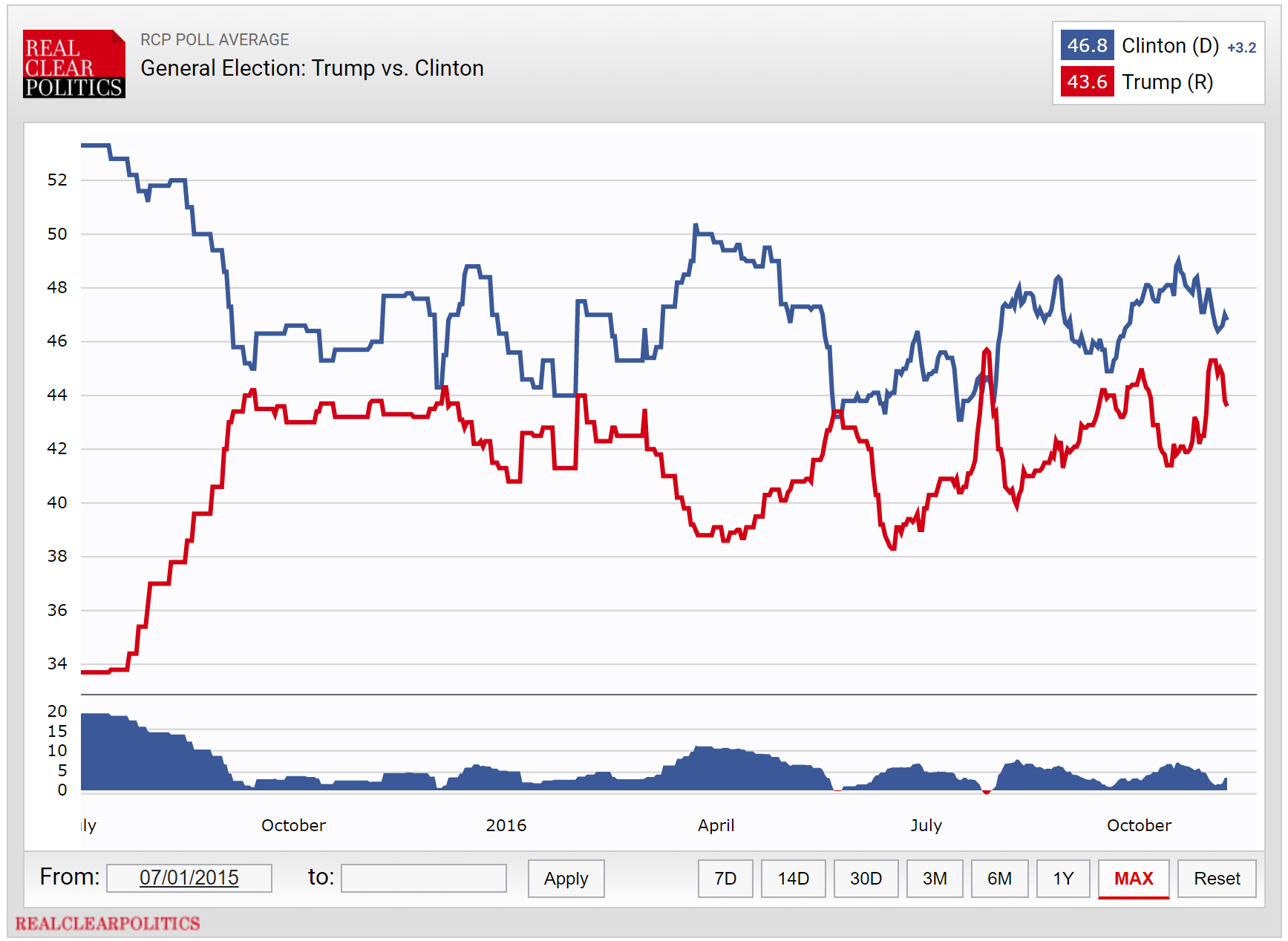
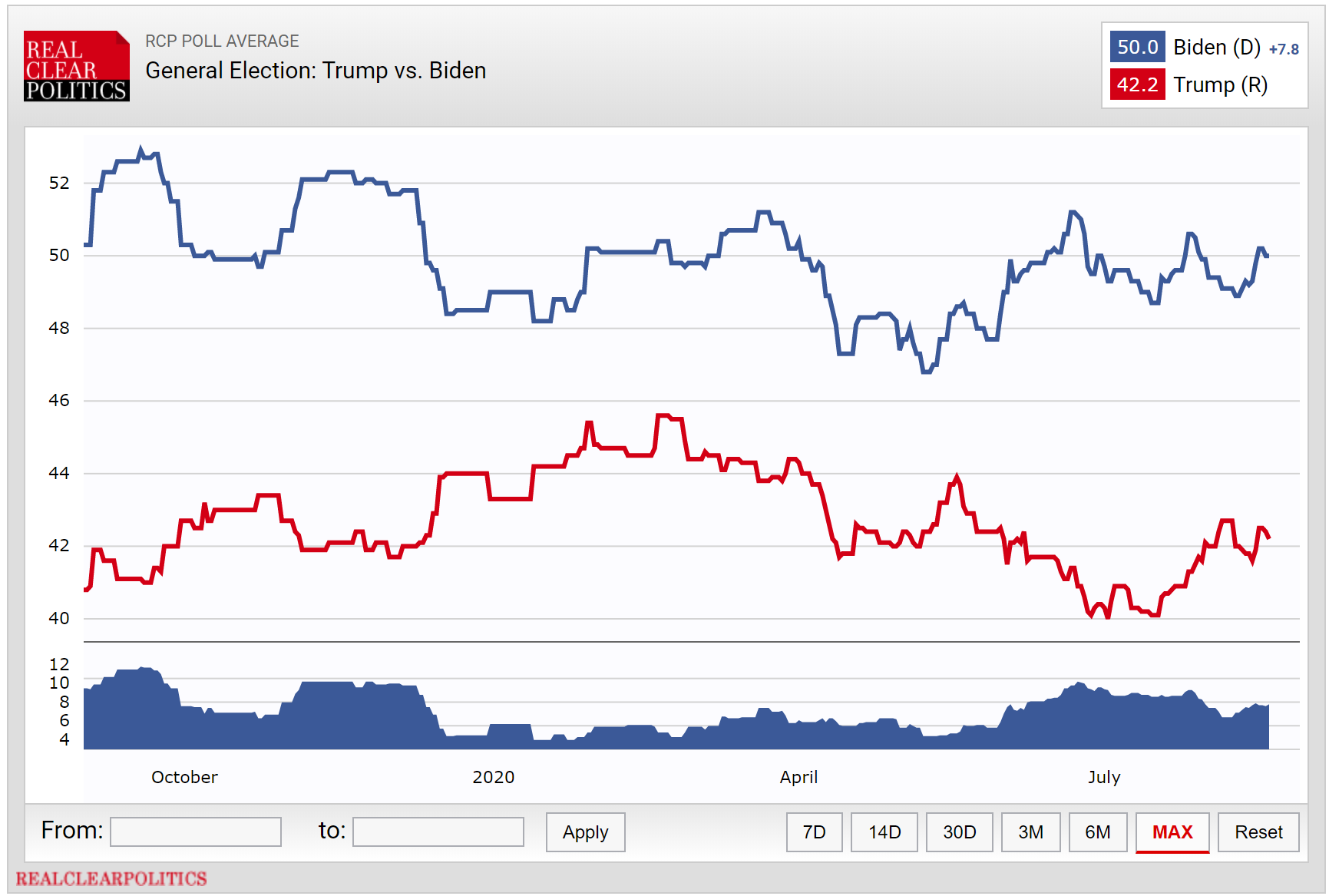
Currently, Joe Biden holds a 7.8% lead nationally. But again, the popular vote is not how the election is won. Hillary Clinton won the popular vote but lost the election 306-232 in the electoral college. After the 2018 midterm elections and the power shift in the House of Representatives, I decided to dig into the Electoral College from 2016 and contrast it with the 2018 results, in an effort to see what paths could emerge for President Trump or the Democratic nominee. Ultimately, I concluded that without any other states flipping, 2020 would come down to Michigan, Pennsylvania, and Wisconsin. On page 2 you will see a map with the 2016 election results.

In 2016, President Trump won Wisconsin and Pennsylvania by 0.7% and Michigan by 0.3%. Assuming no other changes, if less than 1% of the vote changed in these three states, the map in 2020 would look like this:

Since the 2016 election, Democrats have taken back the House of Representatives while Republicans have gained one seat in the Senate. Looking at the three states that I have keyed in on, there has been no change in the Senate, but in Michigan and Pennsylvania there was a shift in House seats. Michigan also saw a Democratic governor elected in 2018, although said governor is not currently popular due to coronavirus lockdown measures.
So where do things stand in these states now? (I am going to include Florida polling as no Republican has won the presidency without Florida since Calvin Coolidge in 1924.)


Currently, Biden holds a substantial lead in the polls in all four states listed. It should be noted that Hillary Clinton held larger leads in the polls at this time in 2016, but those leads evaporated into the margin of error by the election. Below are the 2016 Real Clear Politics polling averages for the four states listed.

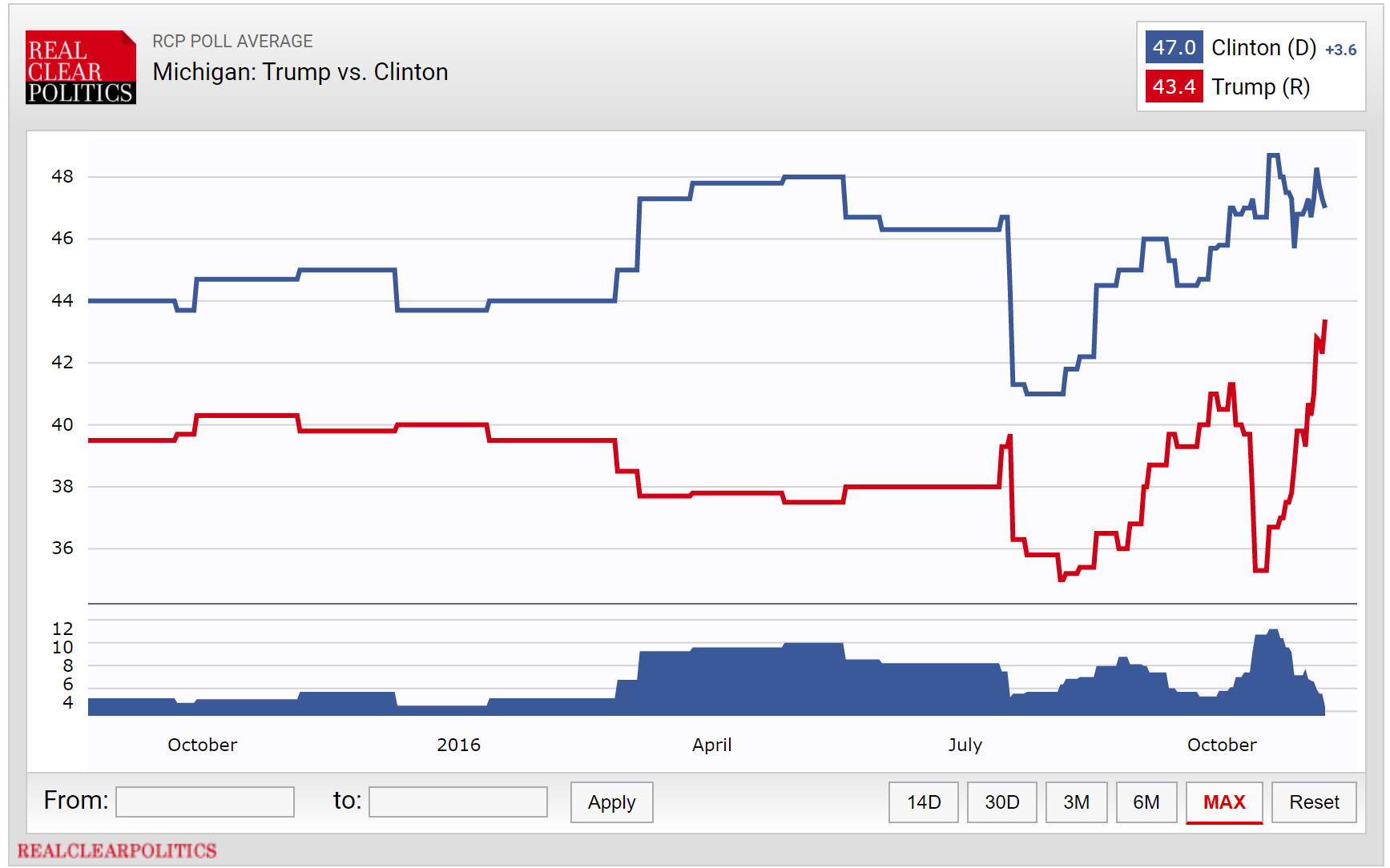
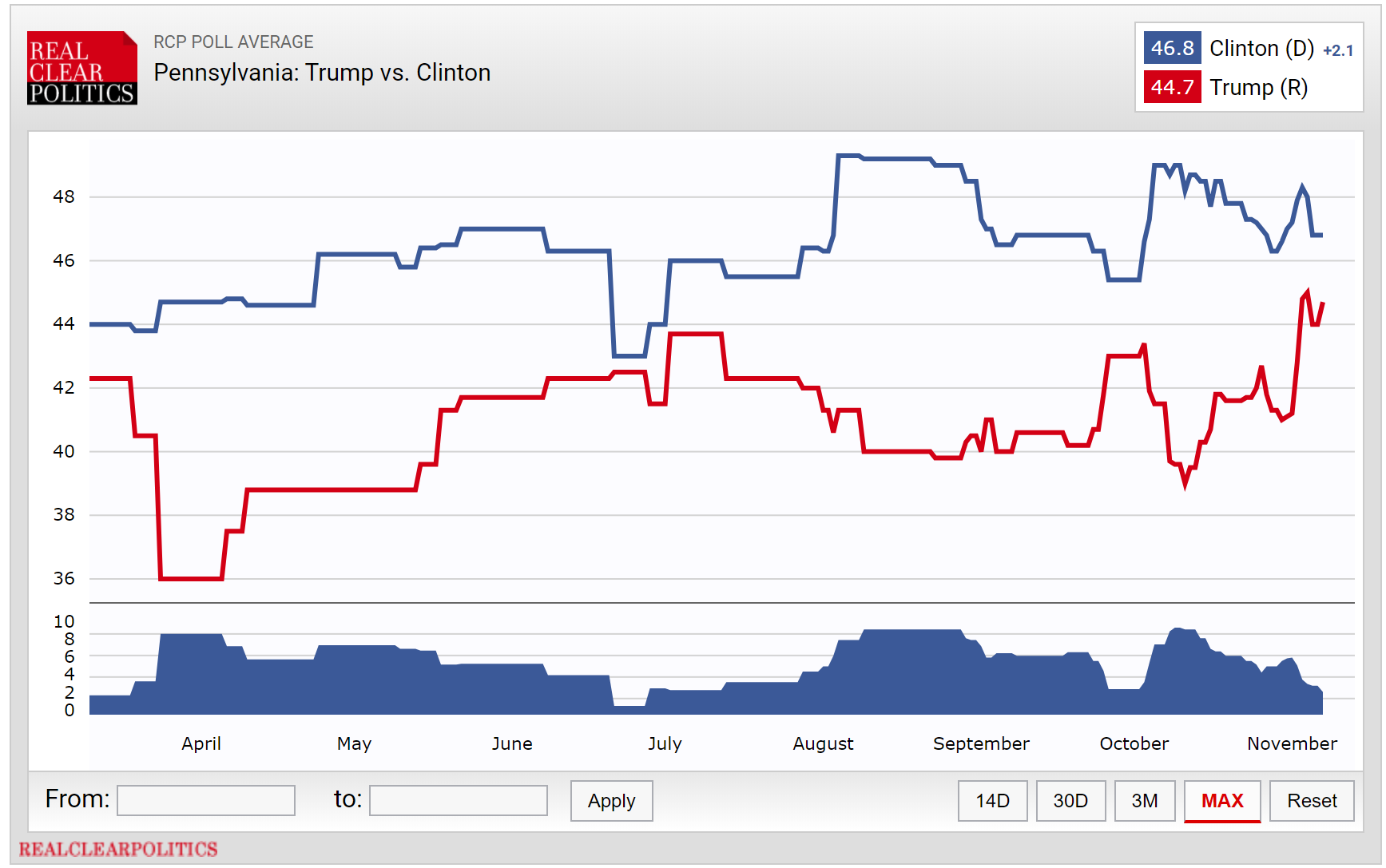
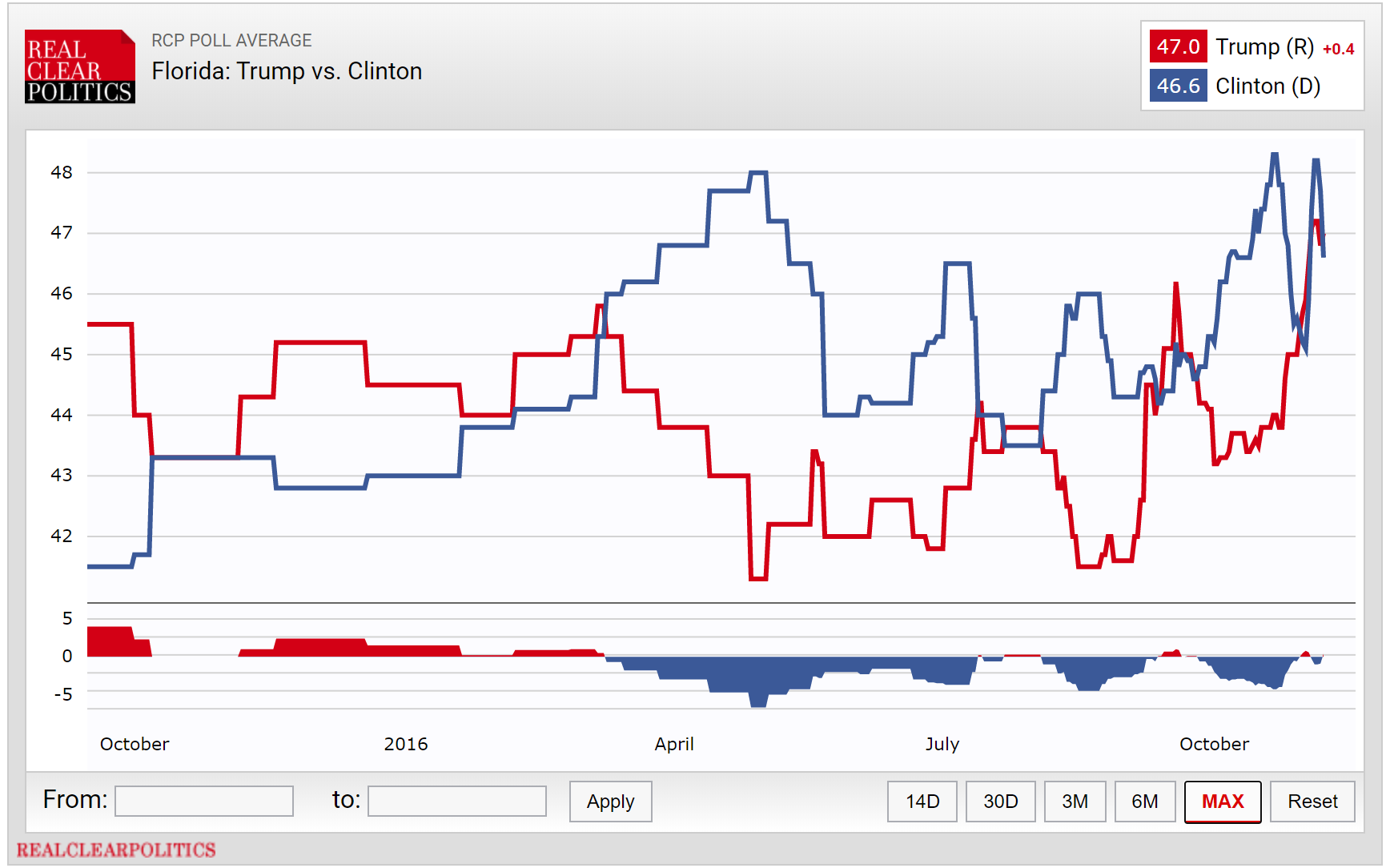
I fully anticipate the polls to tighten up, but as things currently stand, President Trump needs some help. There are a lot of factors that could sway the upcoming elections. There will be debates, a lot of negative advertising, the potential for a second wave of the coronavirus, more government stimulus, and whatever comes out of each candidates’ mouth or fingers (i.e. Twitter). Following an estimated $3.7 trillion deficit this fiscal year on the back of 20 years of deficits, and in the midst of a global pandemic, there is a lot to consider on the fiscal side. At the same time, public health, social change, income equality, and the environment are major issues in the 2020 election. Assuming a Biden victory, which is no guarantee, it appears that what happens down ballot in the Senate could be the bigger story as it would either give the Democrats full reign or maintain the checks and balances of a divided government.
“A dream can inspire you, a plan gets you moving”
Mike DiGirolamoOwner & Host at LaCucina Sabina, LLC
SCAMS IN THE TIME OF PANDEMICS
Juli-Ann Marquette, Strategic Development & Client Advocacy
As a follow-up to an article in our Summer 2020 Newsletter, I wanted to provide information regarding a current trend in the COVID-19 era.
Fraudsters are now stealing personal identifying information (Social Security Number, Date of Birth, etc.), and signing up for unemployment benefits under the victim’s name. According to law enforcement, they are definitely seeing a rise in police reports related to these crimes.
If you have concerns, head over to the web and check out your credit report at either www.transunion.com, www.equifax.com, or www.experian.com. You can place alerts on your credit through these bureaus requesting that potential creditors contact you prior to granting credit in the event a fraudster is attempting to steal your identity.

For further information regarding the potential fraud on your unemployment benefits, please visit the Mississippi Department of Employment Security. https://www.mdes.ms.gov/information-center/fraud-and-integrity/be-aware-of-potential-fraud/
THIS TIME IS DIFFERENT
Danny Williams, CFP®
We have been experiencing some unusual times the past few months. I believe most of us would agree that this is an understatement. The COVID virus has definitely taken over the daily headlines along with ongoing tensions with China. Things have changed for most of us in one way or another, and adjustments have been made in our daily routines.
As is usually the case, no one saw this coming and the market took a fast and furious downturn beginning in mid-February 2020 and bottomed on March 23, 2020. In 33 days, the S&P 500 index was down 35%. During March, the S&P 500 index saw a down 7.6% day, a down 9.5% day, and a down 12% day. We have seen a remarkable market recovery since the March market bottom, but no one knows where it will be a year from now.
Many of you remember the 2008 financial crisis (referred to as the “Great Recession”) and the many challenges that faced our economy and our financial system back then. This was fueled by the widespread use of mortgage-backed securities, backed by the U.S. housing sector. You may recall that the U.S. Congress and the Federal Reserve helped stabilize the markets utilizing a massive government funding program. During this bear market (2007-2009), the S&P 500 index lost about 50% of its value.
Twenty years ago, another recent market crash was the “Dot.com bust” of 1999-2000, when the Nasdaq index bubble burst and declined by more than 75%. This market crash was related to the speculation on technology stocks—many investors were looking at internet-based companies without regard to their financial soundness.
Another memorable day in the market was Black Friday, October 19, 1987, the S&P 500 index was down 20.5% in one day. One year later, the index was up over 23%.
Some of us have grown accustomed to market volatility with its opportunity for higher returns while some would just as soon receive a lower return to avoid these downturns and the emotional fallout that comes with them. As I have written about in past articles, the markets will have downturns along the way, so we need to be prepared and proactive with our portfolio design and planning.
If we have a longer-term time horizon, these volatile markets may be less concerning because we know that over time, the markets should reward an investor with an 8-10% average annual return. On the flip side, if someone is just entering their retirement years, the tolerance for market risk is usually much less.
You may have seen illustrations of what asset value grows to during retirement when the beginning returns are healthy, positive returns as opposed to starting with two to three years of negative returns coupled with needed income distributions. You may have heard this described as “sequence of return risk.” There are planning techniques that can help minimize this risk through our financial planning process.
We realize every investor is unique and needs a customized plan and portfolio design. The time to look at these things is when the market is closer to its highs and before you enter your retirement years. A couple of questions you may want to ask yourself:
- Looking back several months, how did I feel when my account value was going down and the unknown future impact of Covid-19?
- Did I sell some or all my investments after market declines?
- Do I fully understand the range of returns that are likely with a portfolio like mine?
These are just a few questions that you may want to ask yourself regarding your need for planning or a redesign of your portfolio. Give us a call if we can help you take control and set realistic expectations.

